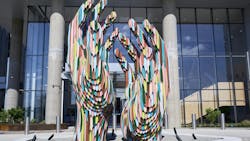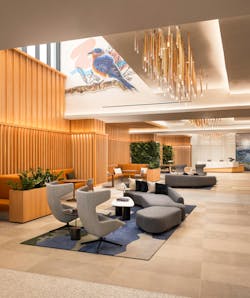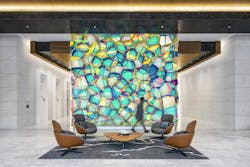Beyond Beauty: How Strategic Art Installations Increase Building Value
Want to boost the value of your building, elevate the tenant experience, and even lower crime rates? Consider art. While property owners typically concentrate on utilitarian upgrades like flooring, lighting, or HVAC systems, there is increasing data that shows thoughtfully selected visual art delivers real ROI, encouraging higher rents, improving tenant satisfaction, and increasing property value.
Urban studies have quantified these benefits. Research from the University of Cincinnati found a 30% rise in weekend foot traffic in neighborhoods with murals compared to those without them. Additionally, Miami’s Design District saw visitor traffic climb 47% after introducing murals and sculptures. These figures suggest public artworks beautify spaces and make commercial areas more inviting and economically robust.
But the return goes deeper, making a property safer and more appealing to the community. After the installation of murals in Cincinnati neighborhoods, scientists reported a drastic 28% drop in violent crime. Public art sends a clear message about investment in the community’s health, generating areas that promote positive social contact and reduce crime.
Art in the Era of Hybrid Work
The return on art is especially timely as businesses weather the long-term effects of the hybrid work model. According to JLL’s latest analysis of trends in the office market, 60% of vacant office space now requires radical overhauls to remain competitive, and tenants’ demands have radically changed towards high-quality experience.
Employers need to create office experiences that people cannot get at home to entice people back to the office. Workplaces should include a variety of spaces for collaborative and deep work, as well as places to socialize. Art helps set the tone, relaxing or energizing employees and inspiring them to do their most creative work.
TIAA’s Frisco, Texas, office campus perfectly illustrates this tactic. The integration of over 160 hand-selected artworks transformed the building into one of the most attractive offices in the region. The art reflects organizational values like sustainability and community. The unique workplace has scored high in employee satisfaction and was even awarded one of the Coolest Offices in Dallas by the Dallas Business Journal.
From Productivity to Placemaking
Art installations also directly affect productivity and creativity. University of Exeter research established that workplaces with artworks recorded 32% higher productivity levels and enhanced employee morale and motivation. Employees in places with good art reported less stress and greater satisfaction, which directly contributed to operation efficiency.
A study conducted by Toronto Metropolitan University on creative placemaking, a practice that helps give spaces a distinct sense of place, points to art as a key differentiator between destinations that feel welcoming and engaging and those that feel soulless. Creative placemaking helps a community feel connection and a sense of belonging to a space and adds to the overall quality of life.
The university’s research established that public spaces infused with public art significantly improve emotional responses, feelings of safety, and overall comfort. Participants in the study experienced a 63% increase in positive emotions in spaces that incorporated intentional placemaking elements, including public art. These spaces were consistently described as more welcoming, vibrant, and culturally diverse. For workplaces, this translates into better attendance, increased productivity and greater job satisfaction.
Art and placemaking projects also increase buildings’ social appeal and marketability. The Toronto Metropolitan University study documented a remarkable 77% increase in the likelihood that individuals would refer places enhanced by art to their colleagues or friends. Likewise, the likelihood of word-of-mouth or social media sharing of experiences at these locations increased by 74%, creating organic exposure and tenant draw.
The Long-Term Value of Art
The financial benefits of investing in art are equally compelling. Compared to traditional improvements to buildings like furniture and flooring, which depreciate and must be replaced over time, thoughtfully selected original art can maintain value or even appreciate. Art selected for timeless appeal is a long-term asset contributing to the property’s character and value for decades.
Installing art successfully within buildings frequently involves close communication with professional art consultants. Consultants possess a wide range of skills encompassing interior design, project management, and even building standards certification. Art consultants can aid property managers in selecting art that strategically targets sustainability and wellness goals, along with enhancing tenant experiences and potentially earning bonus credits toward building certifications.
Art consultants can also successfully coordinate tenant engagement events. Art walks or creative hands-on activities with local artists ensures the artwork is meaningful and builds community connection. When people share a profound feeling of relation to their space, their job satisfaction and likeliness to remain tenants are enhanced to a vast degree.
Real estate professionals also agree that tenant lifestyle features, like artwork, will become major competition factors in the years to come. As Rob Naso of BGO notes, today’s top tenants don’t just want functional space, they want experiences and spaces that embody comfort and convenience. Similarly, Hilary Spann of BXP identifies the growing need for sustainable, well-designed buildings with unique amenities that foster collaboration and efficiency. Art is included in this vision of delivering improved tenant experiences.
Infusing technology into art can also augment these positive impacts. As JLL’s most recent special report illustrates, tenants increasingly want spaces that integrate seamless digital experiences, such as QR-based building access and smart amenities booking. Art infused with modern technology creates spaces that integrate aesthetics, convenience, and innovation harmoniously, further distinguishing properties in competitive real estate markets.
Investing in art isn’t merely about aesthetics. Strategically integrated art installations add value to property, differentiate buildings in competitive markets, improve tenant retention and productivity, and build greater community bonds. With overwhelming data to support these benefits, the case for art as an investment is undeniable. For facility managers and property owners seeking to thrive amid shifting tenant expectations, budgeting for art is essential to long-term success.
About the Author
Jennifer Brener Seay
Jennifer Brener Seay is the Founder and CEO of Art + Artisans. She has curated over 20M square feet of art in commercial real estate and helped clients create impactful spaces for over two decades.



